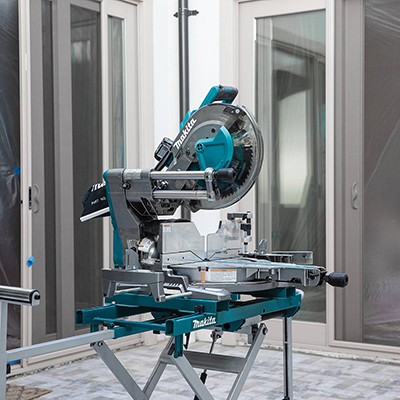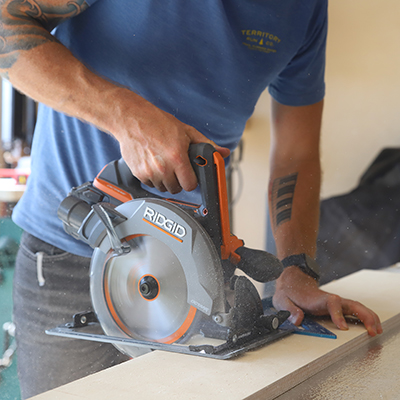How to Use a Circular Saw

Published December 1, 2023
Using a circular saw for straight cuts on your DIY projects might seem intimidating, but these simple tools are easy to use once you know the basics. This guide will teach you how to use a circular saw safely so you can be confident and comfortable when making straight cuts, crosscuts and rip cuts.
Difficulty:
Beginner
Duration:
Under 2 hours
Table of Contents
Circular Saw Basics
How to Use a Circular Saw
How to Cut Straight with a Circular Saw
Circular Saw Cutting Tips
Circular Saw Safety
Circular Saw Basics

A circular saw is a utilitarian workhorse and a useful addition to the toolkit of DIYers. Its most common function is to make cuts in a straight line on pieces of lumber. Knowing its parts makes using a circular saw easier.
- Handle and power trigger: While holding the handle to push the saw forward, squeeze the trigger to start the blade; release it to stop sawing.
- Trigger lock switch: This safety feature prevents the saw from being turned on if the trigger is accidentally squeezed. Deactivate it with your thumb and simultaneously pull the trigger to start the motor.
- Front grip: This secondary handle is for your other hand to help guide the saw along its cutting line.
- Blade guard: A retractable guard covers the circular saw blade when it isn’t operating. When the saw is lined up and ready to cut, the guard is lifted using a tab on its side.
- Shoe: Sometimes called the base of the saw, this is the metal rectangle that rests on top of the material being cut.
- Bevel adjustment knob: Loosen to adjust the angle between the shoe and the saw blade.
- Depth lock knob: Loosen this knob to adjust and set the blade depth.
- Power source: Depending on model, this could be a removable battery on cordless models or a power cord connected to an outlet.
- The blade’s sharp teeth are measured in TPI, or teeth per inch. A higher TPI gives a smoother cut that requires less sanding. Blades with a lower TPI produce faster cuts that are good for rough work. Multi-purpose circular saw blades are available but specially designed varieties should be used when cutting materials like metal, cement fiber board, ceramic tile or plastic.
The base of the circular saw, called the shoe, rests on top of the material being cut. For a regular straight cut, the shoe and the blade are at a 90-degree angle. The angle of the shoe can be adjusted so that body and blade of the saw are tilted to make a bevel cut through material.
How to Use a Circular Saw

Beginners can easily learn how to cut with a circular saw and safely control it to achieve successful results. Like any power tool, however, it can be dangerous if not used properly. Read more about circular saw safety in Step 5.
For a basic cut:
- Measure and mark the cut line.
- Clamp the material firmly to a workstation.
- Attach the appropriate blade to the saw.
- Set the blade depth 1/4-inch below the material you are cutting.
- Confirm the bevel angle.
- Plug the saw’s cord into a power source or attach its battery.
- Rest the saw shoe on the edge of the material and near the cutting line.
- Lift the blade guard.
- With the blade next to but not touching the workpiece, press the lock switch and pull the trigger to get the saw to full speed.
- Keep the shoe firmly on the surface and ease the saw forward to the cutting line while keeping the trigger engaged.
- Guide the saw along the scrap side of the cutting line, keeping the shoe flat
- Let the saw do its work. Pushing with too much force can strain the motor.
- Release the trigger to stop the blade when the cut is complete, then lift the saw and place it on the workbench.
How to Cut Straight with a Circular Saw

There are two types of straight cuts a circular saw can make on a piece of lumber.
- A crosscut is a cut against the grain of the wood, such as when trimming a length of board to size.
- A rip cut goes with the grain of the wood and is usually a longer cut. The term “ripping” could also describe trimming a standard 4-feet x 8-feet piece of plywood to a size of 3-feet x 7-feet, for example.
Accuracy is important when cutting wood. To help prevent cuts from veering away from the cut line, watch the blade as it moves along the line and not only the guide markings that are on the saw’s shoe.
Using a saw guide will ensure the tool cuts in a straight path. Place a speed square across the board you’re cutting, with its lip hanging over the edge. Get your blade aligned with the cut line and slide the straight edge of the speed square against the saw shoe. Hold the square in position as you guide the saw through the board.
For longer rip cuts, such as for sheets of plywood, accessories like a saw guide can help you stay on track. You can create your own by clamping a 1-inch thick board onto the piece you are cutting and using it as a guide for your saw.
Here are a few more tips to help you with crosscutting and rip cuts:
- Crosscutting with a Square: Special squares help guide the saw through a short cut. Put the raised edge against the stock and guide the saw along the other edge.
- Ripping with a Circular Saw: Cutting along the length of the board (ripping) is accomplished with the help of a rip attachment or by clamping a board in place as a guide. The rip attachment is fine for making narrow cuts. For cutting wider pieces, make a cutoff guide.
- Making a Ripping Cut-Off Jig: Make the jig from two strips of 3/4-inch plywood, each 8 feet long. One piece should be about 5 inches wide; the other should be as wide as the saw base plus 5 inches. Have the home center or lumberyard cut them so you'll get straight cuts, then screw them together so that the edges align.
- Guide the saw along the fence piece, cutting the wider piece to width in the process.
- Place the cut edge of the jig along the line and clamp or screw it in place. Guide the saw along the narrower piece to cut along the line.
Circular Saw Cutting Tips

Keep these tips in mind as you are learning how to use a circular saw.
- When appearance matters, make cuts with the good side facing down, as circular saws can splinter the wood on the top side.
- Making your cut line on masking tape can reduce splintering.
- Start over if you see that you've veered off from the cut line instead of trying to curve your way back on track.
- Don't clamp both sides of a cut.
- For efficiency and safety, set the blade depth no more than 1/4-inch below the thickness of the board.
Circular Saw Safety

Safe operation is the most important part of learning how to use a circular saw. These power tools are easy to operate but care should be taken to prevent serious injury.
- Evaluate your tools and workspace for any hazards before you begin. This includes ensuring that your work area is tidy and your saw horse is level and damage free.
- Unplug the saw or remove its battery when changing blades and when not in use.
- Avoid dangerous kickback. Always use sharp blades that are intended for the material to be cut and follow the blade manufacturer’s guidelines.
- Do not attempt to turn on the tool when the blade is against material to be cut.
- Never force the saw while it is cutting. Allow it to cut at its own speed.
- Keep the circular saw shoe firmly placed flat on the cutting surface.
- Wait for the blade to completely stop before lifting the saw from a cut.
- Wear safety glasses to protect your eyes from dust or flying debris, use appropriate ear protection to dampen the loud noise and a dust mask to avoid inhalation of sawdust.
- Keep hands away from moving blades.
- Do not wear loose clothing or jewelry when operating the saw.
A circular saw can be a powerful tool to have in your arsenal. Learning to use one doesn’t have to be intimidating either, especially if you follow proper safety precautions from start to finish.
Whether you’re starting a building project, making furniture or handling serious home repairs, we’ve got the circular saws and circular saw accessories you need.
Ready to find the supplies you need in your local store? Use The Home Depot app to locate products and check inventory. We'll take you to the exact aisle and bay. If you're planning to use a circular saw for a one-time project, consider tool rental at The Home Depot. Use the circular saw for as long as you need it, then bring it back. There’s no maintenance required and you won’t need to store it either.



























